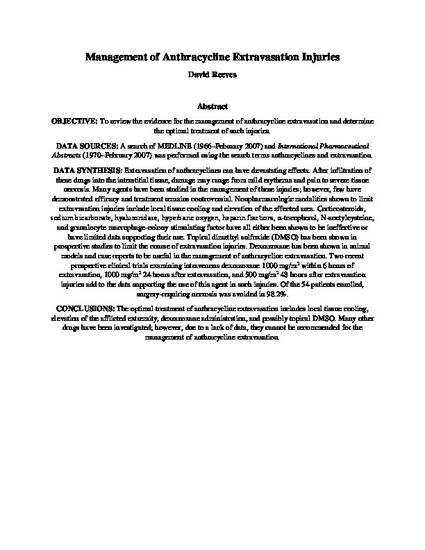
OBJECTIVE: To review the evidence for the management of anthracycline extravasation and determine the optimal treatment of such injuries.
DATA SOURCES: A search of MEDLINE (1966–February 2007) and International Pharmaceutical Abstracts (1970–February 2007) was performed using the search terms anthracyclines and extravasation.
DATA SYNTHESIS: Extravasation of anthracyclines can have devastating effects. After infiltration of these drugs into the interstitial tissue, damage may range from mild erythema and pain to severe tissue necrosis. Many agents have been studied in the management of these injuries; however, few have demonstrated efficacy and treatment remains controversial. Nonpharmacologic modalities shown to limit extravasation injuries include local tissue cooling and elevation of the affected area. Corticosteroids, sodium bicarbonate, hyaluronidase, hyperbaric oxygen, heparin fractions, α-tocopherol, N-acetylcysteine, and granulocyte macrophage-colony stimulating factor have all either been shown to be ineffective or have limited data supporting their use. Topical dimethyl sulfoxide (DMSO) has been shown in prospective studies to limit the course of extravasation injuries. Dexrazoxane has been shown in animal models and case reports to be useful in the management of anthracycline extravasation. Two recent prospective clinical trials examining intravenous dexrazoxane 1000 mg/m2 within 6 hours of extravasation, 1000 mg/m2 24 hours after extravasation, and 500 mg/m2 48 hours after extravasation injuries add to the data supporting the use of this agent in such injuries. Of the 54 patients enrolled, surgery-requiring necrosis was avoided in 98.2%.
CONCLUSIONS: The optimal treatment of anthracycline extravasation includes local tissue cooling, elevation of the afflicted extremity, dexrazoxane administration, and possibly topical DMSO. Many other drugs have been investigated; however, due to a lack of data, they cannot be recommended for the management of anthracycline extravasation.
This is a post-print version of an article originally published in Annals of Pharmacotherapy, 2007, Volume 41, Issue 7-8.
The version of record is available through: Sage.
Available at: http://works.bepress.com/david-reeves/22/
